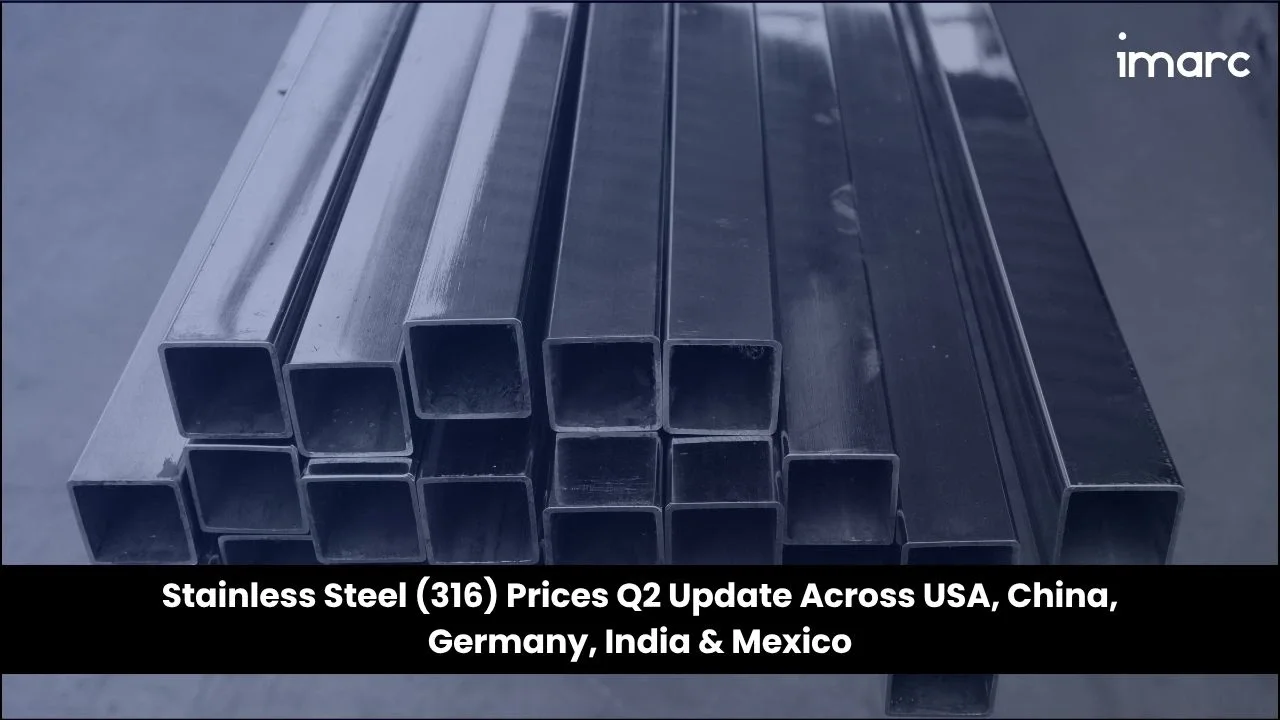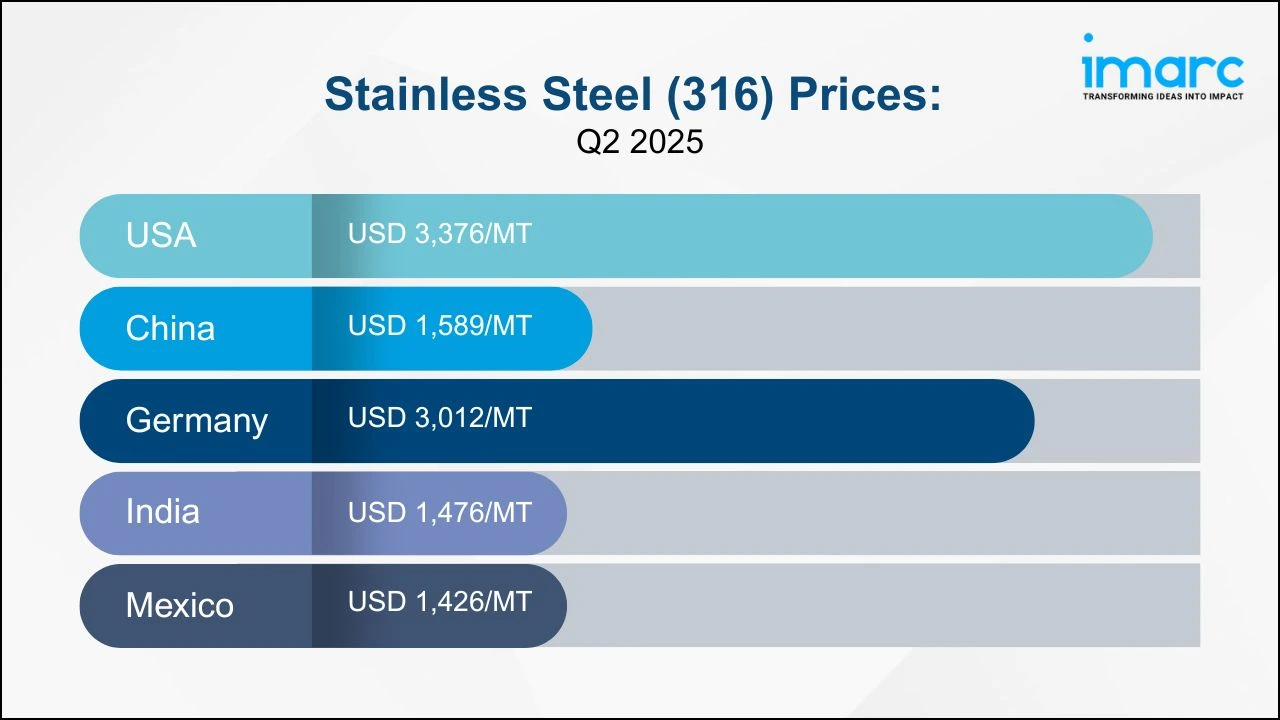Stainless Steel (316) Prices Q2 Update Across USA, China, Germany, India & Mexico
24-Jul-2025
The global stainless steel (316) market experienced varying price movements, influenced by feedstock cost volatility, regional energy dynamics, and sector-specific demand. According to IMARC Group’s latest publication, Stainless Steel (316) Price Index, Trend and Forecast Data Report 2025 Edition, which provides updated insights for Q2 2025, the market witnessed moderate fluctuations as manufacturers navigated raw material pressures and shifting production expenses. The report underscores that the stable demand from industries such as construction, automotive, medical devices, and oil and gas supported a largely balanced market environment. Key markets shaping this trend include North America, Asia Pacific, and Europe, where localized supply chain issues and regulatory challenges add to pricing complexity.
Q2 2025 Stainless Steel (316) Prices:
- USA: USD 3,376/MT
- China: USD 1,589/MT
- Germany: USD 3,012/MT
- India: USD 1,476/MT
- Mexico: USD 1,426/MT

To access real-time prices Request Sample
The present stainless steel (316) prices across key markets reflect the material’s essential role in high-performance sectors like medical devices, marine engineering, and industrial equipment, with steady demand and rising production costs driving a generally stable to upward global pricing trend.
Key Regional Price Trends and Market Drivers:
United States
Stainless steel (316) prices in the United States reached USD 3,376/MT in June 2025. The market saw moderate fluctuations due to variable feedstock costs, particularly nickel and molybdenum. Despite stable demand from the construction and medical sectors, high energy and labor expenses continued to pressure production margins.
China
In China, stainless steel (316) was priced at USD 1,589/MT during Q2 2025. Fluctuations were primarily influenced by input cost variability and environmental compliance. Demand remained steady across construction and chemical sectors, though export policy shifts introduced minor disruptions.
Germany
Germany stainless steel (316) prices rose to USD 3,012/MT in June 2025. Market stability was maintained amid modest fluctuations driven by rising alloy and energy costs. Strong industrial demand from the automotive and infrastructure sectors helped support pricing levels.
India
In India, prices of stainless steel (316) during Q2 2025 reached USD 1,476/MT. Input cost volatility and higher electricity and freight charges influenced local manufacturing economics. Stable demand from the pharmaceutical and construction sectors supported domestic output levels.
Mexico
Mexico stainless steel (316) prices increased to USD 1,426/MT in June 2025. Market fluctuations stemmed from dependency on imported raw materials and nickel price dynamics. Firm demand from the oil and gas and automotive sectors ensured market balance despite rising logistics costs.
Stainless Steel (316) Industry Overview:
The global stainless steel (316) market reached a value of USD 24.34 Billion in 2024 and is projected to grow to USD 36.8 Billion by 2033, expanding at a CAGR of 4.47% during 2025–2033. The material’s widespread industrial relevance, regional energy costs, feedstock availability, and regulatory frameworks are significant factors impacting the market development.
Key drivers contributing to market growth include steady demand from high-performance sectors such as construction, automotive, medical devices, and marine applications, as well as fluctuating input costs for critical alloying elements like nickel and molybdenum. Additional drivers include rising energy and labor expenses, stricter environmental compliance requirements, and supply chain dynamics, which continue to influence production margins and procurement strategies across global markets.
Recent Market Trends and Industry Analysis:
The alloy’s superior corrosion resistance, particularly in chloride-rich and aggressive environments, due to its molybdenum content, makes it suitable for extensive use in highly corrosive environments. As a result, stainless steel (316) is widely used in marine engineering, offshore oil exploration, chemical processing, and wastewater treatment, where durability and long service life are critical.
In addition, the market is further supported by expanding marine infrastructure, rising global seaborne trade, and the development of renewable energy installations such as offshore wind farms. Increasing demand from the chemical, petrochemical, and pharmaceutical sectors, along with tightening environmental and safety regulations across regions, continues to boost the adoption of stainless steel (316). Its strength, recyclability, and resistance to contamination make it an ideal choice for applications requiring both performance and sustainability.
Strategic Forecasting and Analysis:
IMARC’s report incorporates forecasting models that project near-term price movements based on evolving trade policies, raw material supply, and technological trends. These tools enable businesses to mitigate risk, enhance sourcing strategies, and support long-term planning.
Key Features of the Report:
- Price Charts and Historical Data
- FOB and CIF Spot Pricing
- Regional Demand-Supply Assessments
- Port-Level Price Analysis
- Sector-Specific Demand and Supply Insights

.webp)
.webp)
.webp)




.webp)




.webp)












